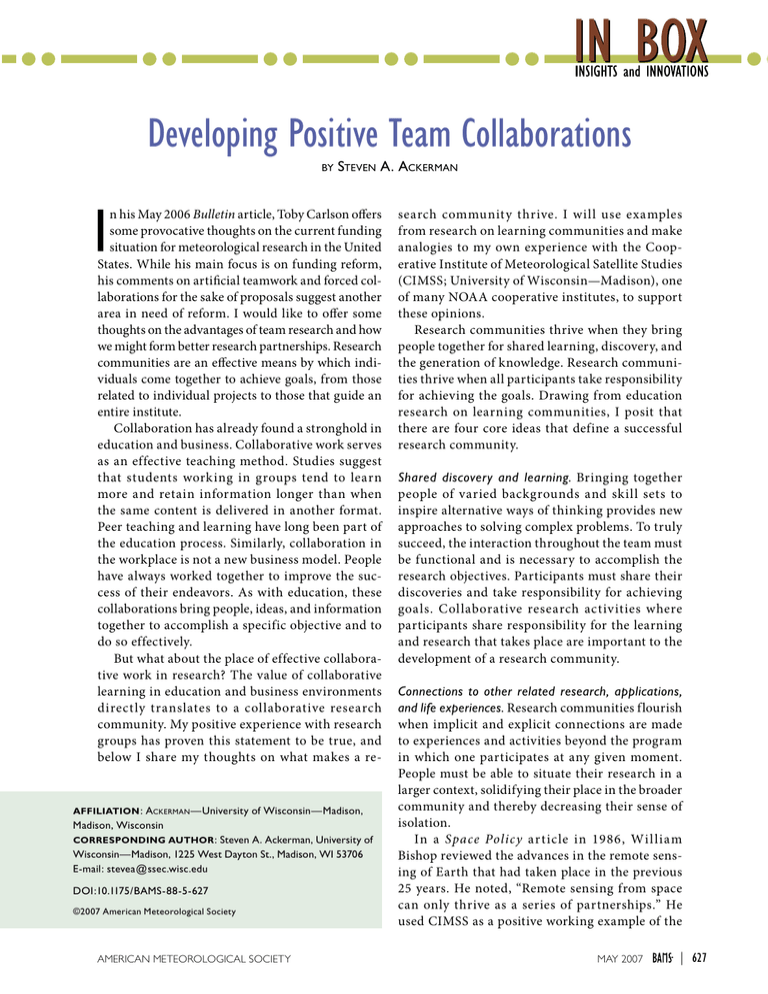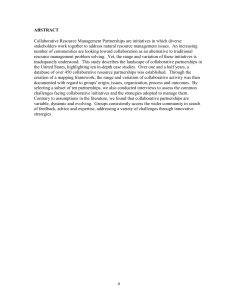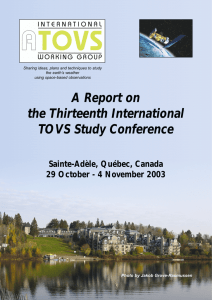I Developing Positive Team Collaborations S A. A
advertisement

Developing Positive Team Collaborations BY STEVEN A. ACKERMAN I n his May 2006 Bulletin article, Toby Carlson offers some provocative thoughts on the current funding situation for meteorological research in the United States. While his main focus is on funding reform, his comments on artificial teamwork and forced collaborations for the sake of proposals suggest another area in need of reform. I would like to offer some thoughts on the advantages of team research and how we might form better research partnerships. Research communities are an effective means by which individuals come together to achieve goals, from those related to individual projects to those that guide an entire institute. Collaboration has already found a stronghold in education and business. Collaborative work serves as an effective teaching method. Studies suggest that students working in groups tend to learn more and retain information longer than when the same content is delivered in another format. Peer teaching and learning have long been part of the education process. Similarly, collaboration in the workplace is not a new business model. People have always worked together to improve the success of their endeavors. As with education, these collaborations bring people, ideas, and information together to accomplish a specific objective and to do so effectively. But what about the place of effective collaborative work in research? The value of collaborative learning in education and business environments directly translates to a collaborative research community. My positive experience with research groups has proven this statement to be true, and below I share my thoughts on what makes a re- AFFILIATION : ACKERMAN —University of Wisconsin—Madison, Madison, Wisconsin CORRESPONDING AUTHOR : Steven A. Ackerman, University of Wisconsin—Madison, 1225 West Dayton St., Madison, WI 53706 E-mail: stevea@ssec.wisc.edu DOI:10.1175/BAMS-88-5-627 ©2007 American Meteorological Society AMERICAN METEOROLOGICAL SOCIETY search community thrive. I will use examples from research on learning communities and make analogies to my own experience with the Cooperative Institute of Meteorological Satellite Studies (CIMSS; University of Wisconsin—Madison), one of many NOAA cooperative institutes, to support these opinions. Research communities thrive when they bring people together for shared learning, discovery, and the generation of knowledge. Research communities thrive when all participants take responsibility for achieving the goals. Drawing from education research on learning communities, I posit that there are four core ideas that define a successful research community. Shared discovery and learning. Bringing together people of varied backgrounds and skill sets to inspire alternative ways of thinking provides new approaches to solving complex problems. To truly succeed, the interaction throughout the team must be functional and is necessary to accomplish the research objectives. Participants must share their discoveries and take responsibility for achieving goals. Collaborative research activities where participants share responsibility for the learning and research that takes place are important to the development of a research community. Connections to other related research, applications, and life experiences. Research communities flourish when implicit and explicit connections are made to experiences and activities beyond the program in which one participates at any given moment. People must be able to situate their research in a larger context, solidifying their place in the broader community and thereby decreasing their sense of isolation. In a Space Policy article in 1986, William Bishop reviewed the advances in the remote sensing of Earth that had taken place in the previous 25 years. He noted, “Remote sensing from space can only thrive as a series of partnerships.” He used CIMSS as a positive working example of the MAY 2007 | 627 government–academia partnership, noting, “The Institute pioneered the computation of wind speeds at cloud heights by tracking cloud features from image to image. These are now a stable product provided from the satellites to the global models at the National Meteorological Center.” This partnership still thrives because of the need, as defined by NOAA, and the expertise at the institutes. NOAA and university scientists share responsibility in the research rather than relying on the expert-centered approach of many faculty-led research groups. CIMSS continues to be a leader in the measurement of winds from satellite observations, and has expanded its expertise to a variety of satellite applications. Through this partnership, over two dozen algorithms from winds to clouds to biomass burning have been successfully transitioned from CIMSS research projects to NOAA operations. This collaboration has f lourished because of the explicit connections between the researchers and the larger community needs. Through the cooperative institute, the university team is conscious of the needs and opportunities beyond an individual project; they appreciate the potential impact of their research on a larger community. Researchers recognize that their work may find its way into the hands of other users. The recent successful launch of the Cloud–Aerosol Lidar and Infrared Pathfinder Satellite (CALIPSO) and Cloudsat are positive examples of NASA collaborations. Functional connections among researchers. The opportunity for collaboration should be strongly supported in research. Research communities thrive when the interactions among researchers are meaningful and functional, and are necessary to accomplish the work. We should turn to each other to explore ideas and get feedback on answers to questions. Meaningful connections must extend throughout the entire research community—among students, postdoctorate fellows, faculty, and staff. Participation in well-functioning cooperative groups supports individual confidence and fosters positive feelings about the research, as well as the individual’s role. For teams to be successful, all members must contribute. Bringing people together merely to fulfill proposal requirements is akin to bribing people to work in groups. The motivation must be an interest in the opportunity to collaborate and learn from each other, and to break out of the 628 | MAY 2007 traditional individualistic competitive research framework. This requires that all members value the unique contribution of other team members and recognize that intellectual growth stems from relationships between all group members. Inclusive environment. Research communities succeed when the diverse backgrounds and experiences of participants are welcomed in such a way that they help to inform the group’s collective research. Group members need to reach out and connect with others from backgrounds different from their own. There is empirical evidence that a variety of perspectives can stimulate idea production, and that group heterogeneity contributes to this enhancement of group creativity. While there are potential downsides to very diverse groups (such as communication issues or lower performance in the early stages of group work), teams that learn how to capitalize on their variety of perspectives will likely generate higher-quality ideas. Developing a diverse group can be difficult, and it sometimes needs to be done intentionally, not only through hires, but also through postdoctorate positions, international collaborations, or partnerships with other institutes. A few final thoughts on building a quality research community remain. Is there an optimum team size? We need teams that are large enough to effectively divide tasks between team members, but small enough to avoid spending excessive time on group management. However, small groups, such as a faculty member and a graduate student, need not be isolated. They can be part of a research community through participation in conferences, workshops, and larger research teams. The faculty–graduate student model of research has and will continue to advance our understanding of the Earth sciences. Undoubtedly, teams will evolve and change size to address new problems. They may evolve to become part of a larger network or develop into a research institute that includes partnerships outside of the organization. These partnerships succeed when there is a real need. CIMSS has grown steadily over its more than 25-year history. This growth was not for the sake of growth, but rather filled a need for maintaining current research strengths while growing into a more collaborative research group to support NOAA goals and foster new research interests of the principal investigators. Throughout this growth, the expertise of scientific programmers, students, and staff were valued as much as that of the principal investigators and administrators, which is another key to building a strong team. Finally, easy access to fellow members in a research community is important, and face-to-face discussions help in the sharing process. Good communication is critical to the community’s success. As the field continues to grow and the funding pool continues to shrink, the need for purposeful and productive collaboration rises. We need to reexamine our research communities, find ways to make them more collaborative and more effective, and help them to thrive. AMERICAN METEOROLOGICAL SOCIETY FOR FURTHER READING Bishop, W. P., 1986: Partnerships in remote sensing: A theme with some examples. Space Policy, 2, 322–341. Brower, A. M., and K. Dettinger, 1998: What is a learning community? Towards a comprehensive model. About Campus, 3, 15–21. Carlson, T. N., 2006: Deficiencies in the present funding process in meteorology. Bull. Amer. Meteor. Soc., 87, 567–570. Hesse, M., and M. Mason, 2005: The case for learning communities. Community College Journal, 76, 30–35. McLeod, P. L., S. A. Lobel, and T. H. Cox, 1996: Ethnic diversity and creativity in small groups. Small Group Res., 27, 248–265. MAY 2007 | 629



